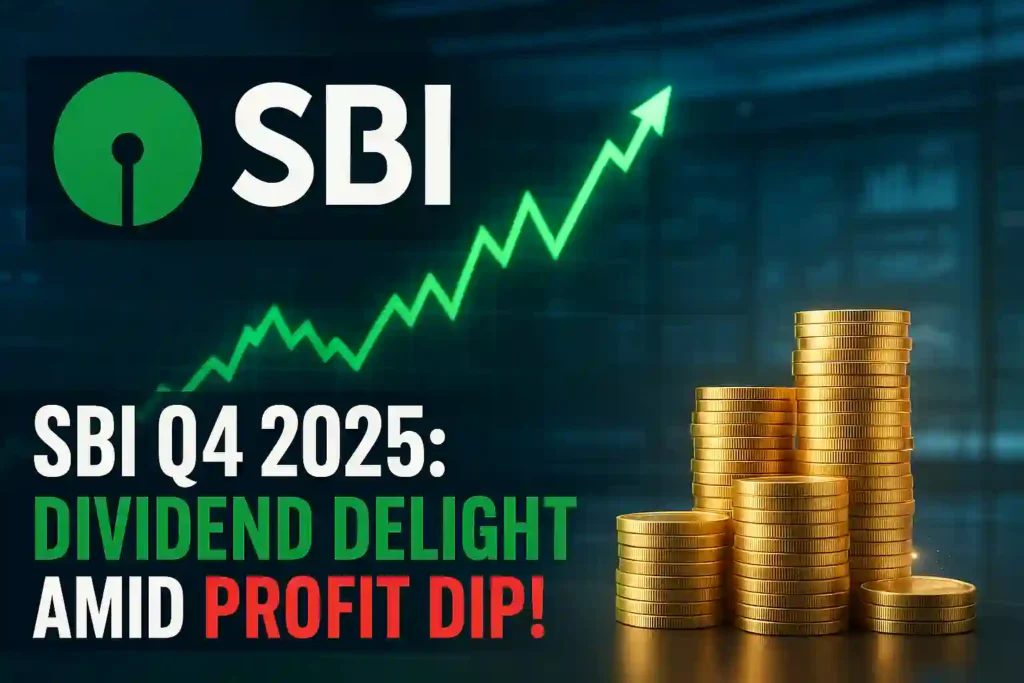Hey there, new investor! If you’re curious about the stock market and wondering whether State Bank of India (SBI) is a good pick for your long-term portfolio, you’re in the right place.
SBI, India’s largest public sector bank, just dropped its financial results for the fourth quarter of FY25 (January-March 2025) on May 3, 2025. As someone who’s been analyzing stocks for over a decade, I’m here to break it down for you in simple terms, like we’re chatting over a cup of chai.
Let’s dive into what these results mean, why they matter, and how they could affect SBI’s stock price—especially for folks like you, aged 25-60, looking to invest for the long haul in India.

What Are Quarterly Results, Anyway?
Before we get into the numbers, let’s clear up what “quarterly results” are. Every three months, companies like SBI share a report card of how they’re doing financially.
This includes how much money they made, how much they spent, and other key details. These results help investors decide whether the company is a good bet for their money.
For a bank like SBI, the results tell us about its profits, loans, and overall health.
SBI is a giant in India’s banking world, serving millions of customers and playing a huge role in the economy. So, when it releases its results, it’s a big deal—not just for SBI shareholders but for the entire banking sector.
The Big Numbers: What SBI Reported
Let’s go through the key highlights of SBI’s Q4 FY25 results, announced on May 3, 2025. I’ll explain each one in plain English so you can understand what’s going on.
| Metric | Value | What It Means |
|---|---|---|
| Net Profit | Rs 18,642.59 crore | Down 10% from Rs 20,698.35 crore last year. It’s the bank’s profit after expenses. |
| Net Interest Income (NII) | Rs 42,774.55 crore | Up 2.7%. Money earned from loans minus what’s paid to depositors. |
| Operating Profit | Rs 31,286 crore | Up 8.83%. Profit from core operations before provisions and taxes. |
| Gross NPA Ratio | 1.82% | Down from 2.24%. Shows fewer bad loans, a sign of better loan management. |
| Net NPA Ratio | 0.47% | Down from 0.57%. Even fewer bad loans after provisions. |
| Provision Coverage Ratio | 74.42% | Up from 73.82%. More money set aside for bad loans, reducing risk. |
| Dividend | Rs 15.90 per share | A cash reward for shareholders, paid on May 30, 2025, if you own shares by May 16. |
| Capital Raising Plans | Up to Rs 25,000 crore | Money to be raised in FY25-26 for growth, like lending or tech upgrades. |
Net Profit: A Slight Dip, But Still Strong
SBI’s net profit—the money left after paying all bills—was Rs 18,642.59 crore. That’s about 186 billion rupees, which is massive! However, it’s 10% less than last year’s Rs 20,698.35 crore for the same quarter.
What’s the deal?
A profit drop might sound worrying, but don’t panic. Banks sometimes see dips due to things like setting aside more money for potential bad loans (called provisions) or one-time expenses. SBI is still making a ton of money, and for long-term investors, this isn’t a deal-breaker. It’s like if your favorite restaurant has a slightly slower month but still serves great food—you wouldn’t stop going there, right?
Dividend: A Sweet Bonus for Shareholders
SBI announced a dividend of Rs 15.90 per share. A dividend is like a thank-you gift from the bank to its shareholders, paid out of its profits. If you own 100 SBI shares, you’ll get Rs 1,590 (100 x Rs 15.90) as a cash payout.
Why this rocks
For long-term investors, dividends are awesome because they give you income without selling your shares. It’s like getting rent from a property you own. The dividend will be paid on May 30, 2025, to shareholders who own the stock by May 16, 2025. This makes SBI attractive if you’re looking for steady returns over time.
Net Interest Income (NII): The Bank’s Bread and Butter
NII is the difference between what SBI earns from loans (like home or car loans) and what it pays to depositors (like interest on your savings account). In Q4 FY25, NII grew by 2.7% to Rs 42,774.55 crore.
What this means
Even though the growth is modest, it’s a good sign. It shows SBI’s core business—lending money—is still bringing in more cash. Think of it like a shop selling more products this year than last year. For long-term investors, steady NII growth means the bank’s main engine is running smoothly.
Asset Quality: Fewer Bad Loans, Less Risk
Asset quality is all about how healthy the bank’s loans are. If too many customers don’t repay their loans, the bank could lose money. SBI’s asset quality improved significantly:
- Gross NPA Ratio (bad loans as a percentage of total loans) dropped to 1.82% from 2.24%.
- Net NPA Ratio (bad loans after setting aside money for them) fell to 0.47% from 0.57%.
- Provision Coverage Ratio (money set aside for bad loans) rose to 74.42% from 73.82%.
Why this is great
Fewer bad loans mean SBI is lending smarter and managing risks better. It’s like a teacher seeing fewer students fail a test because they’re studying harder. For long-term investors, this reduces the chance of big losses down the road, making SBI a safer bet.
Capital Raising: Gearing Up for Growth
SBI plans to raise up to Rs 25,000 crore (250 billion rupees) in FY25-26 through methods like Qualified Institutional Placement (QIP), Follow-on Public Offer (FPO), or rights issues. This is like the bank asking for a big loan or selling new shares to get more money.
What’s the plan
This cash could be used to lend more, upgrade technology (like better mobile apps), or even expand into new areas. It shows SBI is confident about the future and wants to grow. For long-term investors, this is exciting because a growing bank in a growing economy like India could mean higher profits and stock prices in the years ahead.
How Will This Affect SBI’s Stock Price?
Since the results were announced on a Saturday (May 3, 2025), when the stock market was closed, we’ll see the real reaction when trading starts on Monday, May 5, 2025. Here’s what to expect:
- Before the Results: On May 2, 2025, SBI’s stock closed at Rs 800.05, up 1.51% from the previous day (Economic Times). This suggests investors were already feeling positive about SBI.
- What Could Happen: The 10% profit drop might make some investors nervous, potentially pushing the stock price down. But the generous dividend, improved asset quality, and growth plans could balance that out, attracting buyers who see SBI as a solid long-term pick. The stock could stay stable or even rise if investors focus on the positives.
- Analyst Optimism: Big analysts like Motilal Oswal Financial Services are bullish, maintaining a ‘Buy’ rating with a target price of Rs 925 (Economic Times). They expect SBI to grow earnings by 9% annually over FY25-27, with strong returns (Return on Assets of 1.06% and Return on Equity of 16.8% by FY27). This suggests the stock has room to climb, which is encouraging for long-term investors.
Why SBI Is Worth Considering for Long-Term Investors
If you’re an Indian investor aged 25-60 looking for a stock to hold for years, SBI has a lot going for it:
- Market Leader: SBI is India’s biggest bank, with a massive customer base and a strong presence across the country. It’s not going anywhere, which makes it a stable choice.
- Dividend Income: The Rs 15.90 per share dividend is a big draw for those who want regular cash flow. Even if the stock price doesn’t soar, you still get paid.
- Lower Risk: Improved asset quality means fewer bad loans, reducing the chance of big financial hiccups. This makes SBI safer for long-term holding.
- Growth Potential: The Rs 25,000 crore capital raise shows SBI is planning to expand. In a fast-growing economy like India, this could lead to higher profits and stock value over time.
- Analyst Backing: When experts like Motilal Oswal are optimistic, it’s a good sign. Their Rs 925 target price suggests SBI’s stock could rise from its current Rs 800.05.
But, like any investment, there are risks. The banking sector can be affected by economic slowdowns, interest rate changes, or government policies. The 10% profit drop is something to watch—make sure it’s not a sign of bigger issues. Always do your own research or talk to a financial advisor before investing.
The Bigger Picture: Market Context
While we don’t have direct data on how the broader market reacted to SBI’s results (since they were announced on a Saturday), we know the Indian stock market was stable in the week before. The Nifty 50 closed at 24,346.7 (up 0.05%) and the Sensex at 80,501.99 (up 0.32%) (Livemint). The Bank Nifty index was in a range of 52,800–53,700, with potential to move higher. This suggests a calm market, which could support a positive or neutral reaction to SBI’s results, especially given the dividend and asset quality improvements.
Tips for New Investors
If you’re new to investing, here’s how to approach SBI’s results:
- Watch the Stock Price: Check SBI’s stock price on May 5, 2025, to see how the market reacts. You can track it on apps like Moneycontrol or Zerodha.
- Focus on the Long Term: Don’t get too hung up on short-term price swings. SBI’s strengths—like its size, dividends, and growth plans—make it a solid long-term pick.
- Learn More: Visit SBI’s investor relations page (SBI Official Website) for detailed reports or read news on platforms like Economic Times or Livemint.
- Start Small: If you’re unsure, consider buying a few shares to test the waters. You can always add more later if you’re confident.
- Stay Informed: Keep an eye on SBI’s progress, like how it uses the Rs 25,000 crore or improves its digital banking services. These could drive future growth.
Wrapping It Up
SBI’s Q4 FY25 results are a mixed bag, but they lean positive for long-term investors. The 10% profit drop is a bit of a bummer, but the Rs 15.90 dividend, better asset quality, and big growth plans make up for it. As India’s largest bank, SBI is a cornerstone of the economy, and analysts are betting on its future with a ‘Buy’ rating and a Rs 925 target price.
For Indian investors aged 25-60, SBI offers stability, income, and growth potential—perfect for a long-term portfolio. Just keep an eye on the stock price when markets open on May 5, 2025, and stay updated on SBI’s next moves. Investing is a journey, so take it one step at a time, and you’ll get the hang of it!
Key Citations
- SBI Q4 Results: Net Profit Slides 10% YoY to Rs 18,642.59 Crore
- D-Street Ahead: Indian Stock Market Outlook for Next Week
- SBI Q4 Results: Net Profit at Rs 18,643 Crore, NII Up
- State Bank of India Official Investor Relations

Roshan Sharma – Founder of StocksForBeginners.in
I’m Roshan Sharma, a stock market trader with 5+ years of experience. At StocksForBeginners.in, I provide expert fundamental analysis of Indian companies to help long-term investors make informed decisions. My mission is to simplify investing for beginners and share insights from my experience to guide others toward financial growth.